When Does Insulation Need to be Replaced?
When insulation is installed properly, it is a wonderful asset that can keep you and your home warm in the winter and cool in the summer. But what happens if that insulation gets compromised? Insulation needs to be kept dry and in place for it to work properly so once insulation has been compromised, it must be dealt with or replaced. This is because old, compromised insulation can harm you and your family’s health, your home, and your wallet.
Before we get into the discussion of replacing insulation, we will cover the most common types of insulation.
Different Types of Insulation
Fiberglass
Because it is both functional and cost-effective, fiberglass insulation is a popular choice. In most houses, it can survive 80 to 100 years before needing to be rebuilt if it is not damaged. However, after 15 to 20 years, insulation can begin to come out of fiberglass batts, so if your insulation was installed in batts more than a decade ago, it may be time for an inspection or a home energy audit.
Spray foam
Spray foam insulation is one of the most long-lasting, efficient, and dependable types of home insulation available. It has the potential to endure a lifetime or perhaps longer. It does not move and normally stays put until manually removed because it is mold resistant and does not hold moisture.
Many people’s spray foam insulation never has to be replaced. However, if your spray foam insulation has been affected by bad weather, rodents, construction, or other circumstances — or if you are experiencing problems — you may need to replace or repair it.
Cellulose
Cellulose insulation is both environmentally friendly and more effective than other types of insulation at blocking air. However, because it is mostly constructed of recycled materials, cellulose insulation degrades over time. The average lifespan is 20 to 30 years, however degeneration can start as early as 15 years after installation. Similar to other types of insulation, severe weather or outside interference can shorten the lifespan.
Encapsulated
Encapsulated insulation is the best insulation option when insulating your floor. The insulation is installed between the floor joists in the “ceiling” of your crawlspace. This practice closes off the building envelope at the floor of your home.
Encapsulated insulation is fiberglass insulation housed in a vapor retarder to protect your investment from the inherently moist crawl space environment. This type of insulation is available in multiple R-Values (Retention Value), ranging from R19-R30 and is available in multiple widths to suit any floor joist configuration.
How Moisture Affects Insulation

If you have falling or moist insulation, your insulation is not doing its job. Insulation often begins to fall when it absorbs moisture and becomes too heavy. Once your insulation retains moisture, it loses its retention value, rendering itself useless. Wet, damaged, and/or falling insulation can cause more harm than just losing its ability to slow the transfer of heat.
Wet and damaged insulation can cost you thousands of dollars in energy costs. If your insulation is compromised, your heating and cooling systems will need to work much harder to regulate the temperature within your home. Wet insulation can also provide the perfect environment for mold and mildew to grow, therefore compromising your home’s indoor air quality.
To Replace or Not Replace?
If your home is struggling to regulate temperature, there are musty smells in your home, and/or your energy costs have increased, then it is time for a moisture management professional to evaluate the condition of your home’s insulation. These are symptoms of compromised insulation and can be quickly remedied with a professional.
If you’re unsure if your home is experiencing any of these issues but your home is older, we still recommend having a comprehensive evaluation done so that you can be ahead of any issues before they turn into greater, more costly ones. A moisture management professional will be able to evaluate the current conditions of your home’s insulation and give recommendations based on the current conditions and things that may come up in the future.
Insulation Installation by Jersey Shore Crawlspace Enhancement
Our insulation installation services pay for themselves over time by saving our customers on average 17% on their heating and cooling bills throughout the year. We not only look to insulate your home properly, but to take it a step further and identify any other areas that are commonly missed like foundation cracks and air leaks. We perform a comprehensive evaluation of your attic, basement, and/or crawl space before insulating as this helps to identify any issues related to indoor air quality.
If you think that your house is ready for new, energy-efficient insulation, don’t hesitate to reach out to the pros at Jersey Shore Crawlspace Enhancement! Call us or fill out the form below and a Jersey Shore Crawlspace Enhancement representative will reach out to you shortly.
